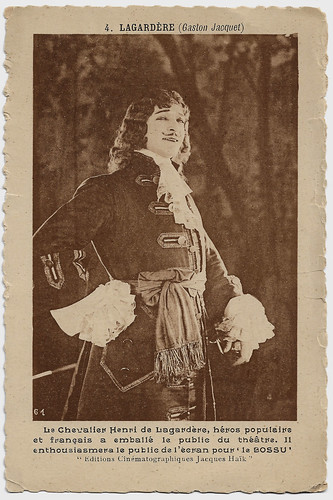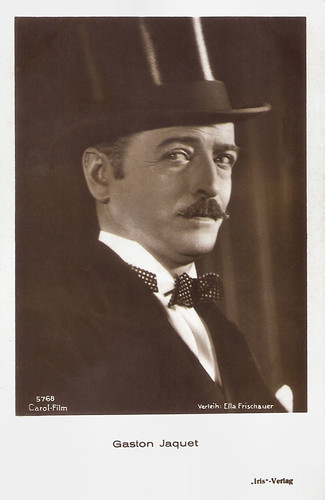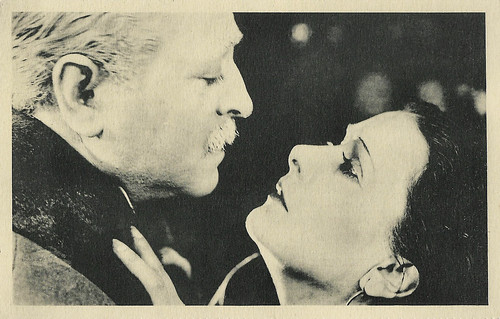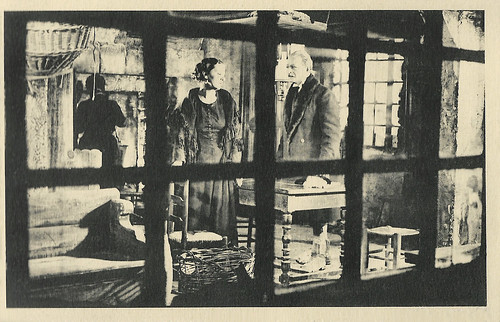Elegant French actor Gaston Jacquet (1883–1970) started his film career during the early silent film era. He played in many films of director Julien Duvivier during the 1920s and 1930s.

French postcard by Editions Cinématographiques Jacques Haïk, no. 4. Photo: Combier Mâcon. Gaston Jacquet as Le Chevalier Henri de Lagardère in Le Bossu/The Duke's Motto (Jean Kemm, 1925).

Austrian postcard by Iris Verlag, no. 5768. Photo: Verleih Ella Frischauer.

French postcard by Cinémagazine Edition, no. 95.

French postcard by Film français Aubert, Paris. Photo: publicity still for Le Tourbillon de Paris/The Maelstrom of Paris (Julien Duvivier, 1928) with Lil Dagover.
Gaston Jacquet was born as Émile Marius Jacquet in Lanas, France in 1883. He started his film career with such silent films as Qui a tué?/Who killed? (Pierre Marodon, 1919) with Elmire Vautier, Le sang des immortelles/The blood of the immortals (André Liabel, 1919) with Marcel Vibert, and Celle qui n'a pas dit son nom/The one who did not say her name (Maurice de Marsan, 1919).
In the early 1920s, he played in dozens of films, such as Les femmes des autres/The Wives of Others (Pierre Marodon, 1920) starring Renée Sylvaire, as De Winter in Les trois mousquetaires/The Three Musketeers (Henri Diamant-Berger, 1921) with Aimé Simon-Girard as D’Artagnan, and L'ouragan sur la montagne/The Hurricane on the Mountain (1922), directed by the young Julien Duvivier. He also starred in Duvivier’s Le reflet de Claude Mercoeur/The Reflection of Claude Mercoeur (Julien Duvivier, 1923) starring Camille Beuve, Coeurs farouches/Wild hearts (Julien Duvivier, 1924) with Rolla Norman, and Credo ou la tragédie de Lourdes/Credo or The Tragedy of Lourdes (Julien Duvivier, 1924).
Their biggest success was the funny extravaganza Le mystère de la tour Eiffel/The Mystery of the Eiffel Tower (Julien Duvivier, 1927) with the boy Jimmy Gaillard, who would become an actor when he grew up. DB DuMonteil at IMDb about the sole remaining copy in the Dutch Eye Institute: “The best of what remains of the original work is the final scenes, on the Eiffel Tower, where Duvivier already showed he would be one of the greatest French directors of all time. He filmed the famous tower in a way that is almost frightening: the steel frames, the cables, everything creates a new world where men are like spiders on a giant web, while the crowd looks like ants on the Champ De Mars.”
The following year they worked again together at L'agonie de Jérusalem/The Agony of Jerusalem (Julien Duvivier, 1928) and Le tourbillon de Paris/The Maelstrom of Paris (Julien Duvivier, 1928) with German star Lil Dagover. Jacquet also played supporting parts in German silent films, such as the Anny Ondra comedies Der erste Kuß/The First Kiss (Carl Lamac, 1928) and Saxophon-Susi/Suzy Saxophone (Carl Lamac, 1928), and in Großstadtschmetterling/Pavement Butterfly (Richard Eichberg, 1929) starring Anna May Wong.
One of his last silent films was Prix de beauté/Beauty Prize (Augusto Genina, 1930) about which James Travers at Films de France writes: “Prix de beauté was one of the last silent masterpieces, directed by Augusto Genina and scripted by René Clair (himself a great director). Released at a time when sound films were becoming the norm, this film was largely overlooked and has only comparatively recently received the attention it deserves. The film stars Louise Brooks in the role of the eponymous tragic femme fatale, a part that suits the beautiful young actress perfectly.”

French postcard by Editions Jacques Haïk. Photo: Combier Mâcon. Publicity still for Le Bossu/The Duke's Motto (Jean Kemm, 1925).

French postcard by Editions Jacques Haïk, no. 5. Photo: Combier Mâcon. Publicity still for Le Bossu/The Duke's Motto (Jean Kemm, 1925). Caption: Lagardère and child.

French postcard by Editions Jacques Haïk, no. 13. Photo: Combier Mâcon. Publicity still for Le Bossu/The Duke's Motto (Jean Kemm, 1925). Caption: Jacques Haïk company made Le Bossu for you ... and Lagardère will make all heads turn.

French postcard by Editions Jacques Haïk, no. 120. Photo: Combier Mâcon. Publicity still for Le Bossu/The Duke's Motto (Jean Kemm, 1925).
In the sound era, Gaston Jacquet continued to appear in international productions and reunited with Anny Ondra in the German comedy Das Mädel aus U.S.A/The Girl from the USA (Carl Lamac, 1930).
In France, he had a supporting part in Le chemin du paradis/The Road To Paradise (Wilhelm Thiele, Max de Vaucorbeil, 1930) starring Lilian Harvey. The latter was the French version of the UFA box office hit Die Drei von der Tankstelle/Three from the Gasoline Station (Wilhelm Thiele, 1930).
Another French version of a popular UFA film was Le vainqueur/The Winner (Hans Hinrich, Paul Martin, 1932) with Jean Murat (the German version was Der Sieger/The Winner (Hans Hinrich, Paul Martin, 1932) with Hans Albers). Jacquet reunited with Julien Duvivier for the latter's first sound film, the drama David Golder (1931), and for the George Siménon adaptation La tête d'un homme/A Man's Neck (1933), both starring Harry Baur.
Other interesting films were the comedy Enlevez-moi/Abduct Me (Léonce Perret, 1932) with Arletty, and the fantasy film Le golem/The Golem (Julien Duvivier, 1936) starring Harry Baur. He also played a small part in Duvivier’s masterpiece La fin du jour/The End of the Day (Julien Duvivier, 1939), starring Victor Francen, Michel Simon and Louis Jouvet as three old and penniless actors living in a near-bankrupt retirement home.
DB DuMonteil at IMDb thinks it is “Probably Duvivier's pre-war peak. His pessimism reaches here such unbelievable heights that we're brooding all along the movie and long after having seen it.” From then on Jacquet’s film appearances became smaller and more incidental. He was seen in such films as Jeunes filles en détresse/Girls in Distress (Georg Wilhelm Pabst, 1939) with Micheline Presle in one of her first roles, and La neige sur les pas/The Snow on the Steps (André Berthomieu, 1942) starring Pierre Blanchar.
His final film appearance followed 15 years later. It was a small part in another film by his old pal Duvivier, Pot-bouille/Lovers of Paris (Julien Duvivier, 1957) starring Gérard Philipe. Gaston Jacquet died in 1970 in Thonex, Switzerland.

Belgian postcard by NV Cacao en Chocolade, Kivou, Vilvoorde, Belgium. Photo: Paramount. Publicity still for an early French sound film.

French postcard by Film français Aubert, Paris. Photo: publicity still for Le Tourbillon de Paris/The Maelstrom of Paris (Julien Duvivier, 1928) with Lil Dagover and Gaston Jacquet.

French postcard by Film français Aubert, Paris. Photo: publicity still for Le Tourbillon de Paris/The Maelstrom of Paris (Julien Duvivier, 1928) with Léon Bary, Lil Dagover and Gaston Jacquet.
Scene from Prix de beauté/Beauty Prize (1930). The original silent film was later dubbed. Source: msatch 1952 (YouTube).
Scene from La fin du jour/The End of the Day (1939). Source: Mr. David Cairns (YouTube).
Sources: James Travers (Films de France), Thomas Staedeli (Cyranos), DB DuMonteil (IMDb), AllMovie, Wikipedia (French) and IMDb.
This post was last updated on 13 November 2024.

French postcard by Editions Cinématographiques Jacques Haïk, no. 4. Photo: Combier Mâcon. Gaston Jacquet as Le Chevalier Henri de Lagardère in Le Bossu/The Duke's Motto (Jean Kemm, 1925).

Austrian postcard by Iris Verlag, no. 5768. Photo: Verleih Ella Frischauer.

French postcard by Cinémagazine Edition, no. 95.

French postcard by Film français Aubert, Paris. Photo: publicity still for Le Tourbillon de Paris/The Maelstrom of Paris (Julien Duvivier, 1928) with Lil Dagover.
The Three Musketeers
Gaston Jacquet was born as Émile Marius Jacquet in Lanas, France in 1883. He started his film career with such silent films as Qui a tué?/Who killed? (Pierre Marodon, 1919) with Elmire Vautier, Le sang des immortelles/The blood of the immortals (André Liabel, 1919) with Marcel Vibert, and Celle qui n'a pas dit son nom/The one who did not say her name (Maurice de Marsan, 1919).
In the early 1920s, he played in dozens of films, such as Les femmes des autres/The Wives of Others (Pierre Marodon, 1920) starring Renée Sylvaire, as De Winter in Les trois mousquetaires/The Three Musketeers (Henri Diamant-Berger, 1921) with Aimé Simon-Girard as D’Artagnan, and L'ouragan sur la montagne/The Hurricane on the Mountain (1922), directed by the young Julien Duvivier. He also starred in Duvivier’s Le reflet de Claude Mercoeur/The Reflection of Claude Mercoeur (Julien Duvivier, 1923) starring Camille Beuve, Coeurs farouches/Wild hearts (Julien Duvivier, 1924) with Rolla Norman, and Credo ou la tragédie de Lourdes/Credo or The Tragedy of Lourdes (Julien Duvivier, 1924).
Their biggest success was the funny extravaganza Le mystère de la tour Eiffel/The Mystery of the Eiffel Tower (Julien Duvivier, 1927) with the boy Jimmy Gaillard, who would become an actor when he grew up. DB DuMonteil at IMDb about the sole remaining copy in the Dutch Eye Institute: “The best of what remains of the original work is the final scenes, on the Eiffel Tower, where Duvivier already showed he would be one of the greatest French directors of all time. He filmed the famous tower in a way that is almost frightening: the steel frames, the cables, everything creates a new world where men are like spiders on a giant web, while the crowd looks like ants on the Champ De Mars.”
The following year they worked again together at L'agonie de Jérusalem/The Agony of Jerusalem (Julien Duvivier, 1928) and Le tourbillon de Paris/The Maelstrom of Paris (Julien Duvivier, 1928) with German star Lil Dagover. Jacquet also played supporting parts in German silent films, such as the Anny Ondra comedies Der erste Kuß/The First Kiss (Carl Lamac, 1928) and Saxophon-Susi/Suzy Saxophone (Carl Lamac, 1928), and in Großstadtschmetterling/Pavement Butterfly (Richard Eichberg, 1929) starring Anna May Wong.
One of his last silent films was Prix de beauté/Beauty Prize (Augusto Genina, 1930) about which James Travers at Films de France writes: “Prix de beauté was one of the last silent masterpieces, directed by Augusto Genina and scripted by René Clair (himself a great director). Released at a time when sound films were becoming the norm, this film was largely overlooked and has only comparatively recently received the attention it deserves. The film stars Louise Brooks in the role of the eponymous tragic femme fatale, a part that suits the beautiful young actress perfectly.”

French postcard by Editions Jacques Haïk. Photo: Combier Mâcon. Publicity still for Le Bossu/The Duke's Motto (Jean Kemm, 1925).

French postcard by Editions Jacques Haïk, no. 5. Photo: Combier Mâcon. Publicity still for Le Bossu/The Duke's Motto (Jean Kemm, 1925). Caption: Lagardère and child.

French postcard by Editions Jacques Haïk, no. 13. Photo: Combier Mâcon. Publicity still for Le Bossu/The Duke's Motto (Jean Kemm, 1925). Caption: Jacques Haïk company made Le Bossu for you ... and Lagardère will make all heads turn.

French postcard by Editions Jacques Haïk, no. 120. Photo: Combier Mâcon. Publicity still for Le Bossu/The Duke's Motto (Jean Kemm, 1925).
Old Pal Duvivier
In the sound era, Gaston Jacquet continued to appear in international productions and reunited with Anny Ondra in the German comedy Das Mädel aus U.S.A/The Girl from the USA (Carl Lamac, 1930).
In France, he had a supporting part in Le chemin du paradis/The Road To Paradise (Wilhelm Thiele, Max de Vaucorbeil, 1930) starring Lilian Harvey. The latter was the French version of the UFA box office hit Die Drei von der Tankstelle/Three from the Gasoline Station (Wilhelm Thiele, 1930).
Another French version of a popular UFA film was Le vainqueur/The Winner (Hans Hinrich, Paul Martin, 1932) with Jean Murat (the German version was Der Sieger/The Winner (Hans Hinrich, Paul Martin, 1932) with Hans Albers). Jacquet reunited with Julien Duvivier for the latter's first sound film, the drama David Golder (1931), and for the George Siménon adaptation La tête d'un homme/A Man's Neck (1933), both starring Harry Baur.
Other interesting films were the comedy Enlevez-moi/Abduct Me (Léonce Perret, 1932) with Arletty, and the fantasy film Le golem/The Golem (Julien Duvivier, 1936) starring Harry Baur. He also played a small part in Duvivier’s masterpiece La fin du jour/The End of the Day (Julien Duvivier, 1939), starring Victor Francen, Michel Simon and Louis Jouvet as three old and penniless actors living in a near-bankrupt retirement home.
DB DuMonteil at IMDb thinks it is “Probably Duvivier's pre-war peak. His pessimism reaches here such unbelievable heights that we're brooding all along the movie and long after having seen it.” From then on Jacquet’s film appearances became smaller and more incidental. He was seen in such films as Jeunes filles en détresse/Girls in Distress (Georg Wilhelm Pabst, 1939) with Micheline Presle in one of her first roles, and La neige sur les pas/The Snow on the Steps (André Berthomieu, 1942) starring Pierre Blanchar.
His final film appearance followed 15 years later. It was a small part in another film by his old pal Duvivier, Pot-bouille/Lovers of Paris (Julien Duvivier, 1957) starring Gérard Philipe. Gaston Jacquet died in 1970 in Thonex, Switzerland.

Belgian postcard by NV Cacao en Chocolade, Kivou, Vilvoorde, Belgium. Photo: Paramount. Publicity still for an early French sound film.

French postcard by Film français Aubert, Paris. Photo: publicity still for Le Tourbillon de Paris/The Maelstrom of Paris (Julien Duvivier, 1928) with Lil Dagover and Gaston Jacquet.

French postcard by Film français Aubert, Paris. Photo: publicity still for Le Tourbillon de Paris/The Maelstrom of Paris (Julien Duvivier, 1928) with Léon Bary, Lil Dagover and Gaston Jacquet.
Scene from Prix de beauté/Beauty Prize (1930). The original silent film was later dubbed. Source: msatch 1952 (YouTube).
Scene from La fin du jour/The End of the Day (1939). Source: Mr. David Cairns (YouTube).
Sources: James Travers (Films de France), Thomas Staedeli (Cyranos), DB DuMonteil (IMDb), AllMovie, Wikipedia (French) and IMDb.
This post was last updated on 13 November 2024.
No comments:
Post a Comment